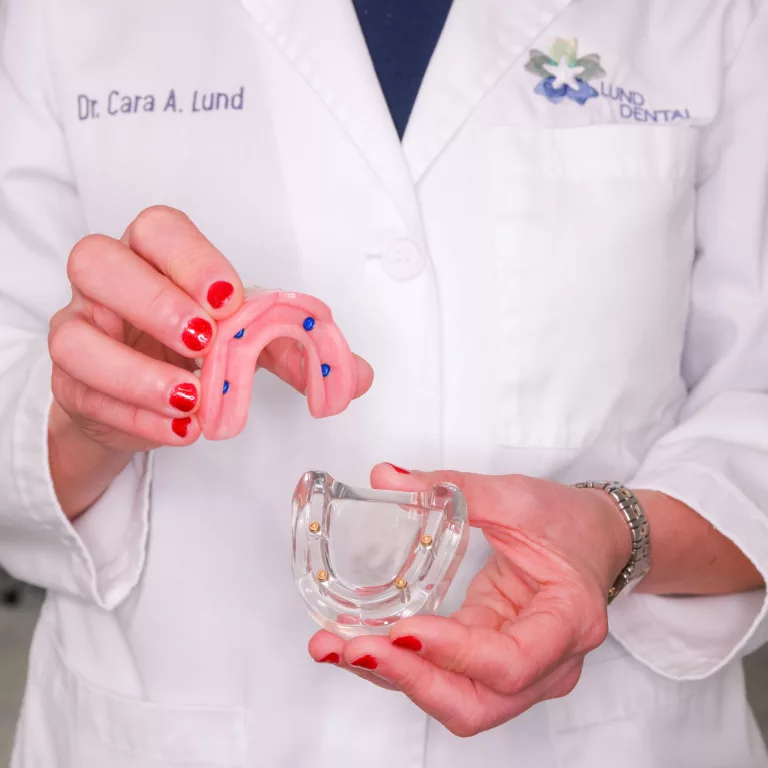Partial & Complete Dentures

Partial or Complete Dentures to replace missing teeth
Partial and complete dentures are appliances that are inserted in the mouth, replace natural teeth, and provide support for the cheeks and lips.
Most dentures are made of acrylic and can be fabricated 2 different ways.
Complete Dentures to Replace Missing Teeth
A denture or complete dentures as they are often called, is an appliance that is inserted in the mouth, replaces natural teeth and provides support for the cheeks and lips.
Most dentures are made of acrylic and can be fabricated 2 different ways.
- A conventional denture is made after all teeth have been extracted and the tissues (gums) have healed.
- An immediate denture is fabricated and inserted immediately after the teeth are extracted and the tissues are allowed to heal under the denture.
- An upper denture has acrylic, usually flesh colored, that covers the palate (roof of the mouth).
- A lower denture is shaped like a horseshoe to leave room for the tongue.
- If not all the teeth are missing, it is called a partial denture.
Partial and complete dentures can be fabricated to fit over endodontically treated teeth or attached to dental implants to allow for a more secure fit.
Dentures over a normal course of time will wear and need to be replaced or relined in order to keep the jaw alignment normal. The alignment will slowly change as the bone and gum ridges recede or shrink due to the extraction of the teeth. Regular dental examinations are still important for those wearing complete dentures so that the oral tissues can be checked for disease or change.
What to Expect
New dentures always feel strange when first placed in your mouth. Several days or even a few weeks will be required for you to feel accustomed to them.
Sore Spots: Usually, your mouth will have a few “sore spots” after wearing the dentures for 24 hours. They are normal. They can be relieved with very little effort during your next appointment. Another appointment about 7 days later will usually eliminate any additional sore areas.
Chewing: The new bite may not feel completely comfortable for a period of days. We will adjust the contacting surfaces of your teeth in 24 hours and again about 1 week after the dentures have settled into place.
Upper vs. Lower Dentures: Your upper denture will rest comfortably in place with moderate to strong “suction.” Although your lower denture will have good stability, it is infrequent that “suction” can be expected on a lower denture. We suggest that you avoid denture adhesives unless you have significant difficulty, because they alter the fit of the denture over a period of time.
Cleaning the Dentures and Your Mouth: Your dentures can be cleaned by using a soft bristle toothbrush and soapy water or a mild toothpaste. Denture soaks are also useful for the denture. Leave the dentures out of your mouth at night. When not in your mouth, the dentures should be soaking in water to avoid warping the plastic. Brush your gums with a regular toothbrush once per day to toughen and clean them.
What to Expect in the Future: Your jaw bones and gums shrink up to 1/32 of an inch per year after your teeth are extracted. This shrinkage is one of the main disadvantages of artificial dentures. Because of this shrinkage, you should plan to have your dentures and oral tissues evaluated once per year by us. We will inform you when refitting of the dentures is necessary. Wearing ill-fitting dentures for too long without refitting can cause severe bone loss and serious oral diseases.Your jaw bones and gums shrink up to 1/32 of an inch per year after your teeth are extracted. This shrinkage is one of the main disadvantages of artificial dentures. Because of this shrinkage, you should plan to have your dentures and oral tissues evaluated once per year by us. We will inform you when refitting of your complete dentures is necessary. Wearing ill-fitting dentures for too long without refitting can cause severe bone loss and serious oral diseases.

